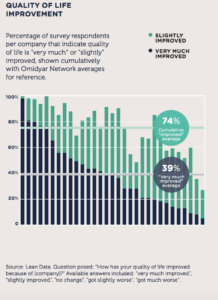The idea of using data to drive social impact sounds sexy, cool and exciting. But what does it mean in practice? Where are the tangible examples of how it is being done?
Let’s first start with a more basic question. What constitutes social impact? To me, social impact occurs when a person has experienced a meaningful change in their quality of life. And how do you know if someone’s quality of life is improving or getting worse? Well, you can just ask them. Have a conversation. Listen.
Ask enough people, listen to enough voices, and perhaps you can start to understand the drivers of social impact.
That’s exactly what we’ve been doing at Lean Data. We have used technology (phone, SMS, online) to have conversations with over 70,000 low-income consumers in 27 countries. We have these conversations on behalf of social enterprises and impact investors who want to know whether they are improving people’s lives, and what they can do better. We ask questions around value proposition, perceived impact, and suggestions for improvement — careful to ensure the questions are engaging and allow the customer to express themselves freely.
Each voice, each response to a question, becomes a valuable data point. When we aggregate these voices, we start to get a bird’s eye view of how, where and why social impact is taking place.
Take Omidyar Network — in my view, one of the most forward-thinking impact investors. In the summer of 2017, we completed a Lean Data “Sprint”, surveying 11,500 customers across 36 portfolio companies. One of the questions customers were asked was: “Has your quality of life changed because of [company]?”. Each bar on the chart represents a portfolio company. The higher the bar, the greater the customer-reported social impact. For the first time, Omidyar Network was able to directly identify which portfolio companies, in the eyes of the customer, were having the strongest impact on quality of life.

Or take Acumen, where Lean Data was incubated and where we’ve done our most in-depth work in the Energy sector. Acumen has invested in several off-grid energy and clean cookstove companies. Looking at just one dimension of impact — monetary savings — companies that look similar on paper (e.g. pay-as-you-use solar home companies) are having very different levels of impact in practice. You can find out more here.

For investors such as Omidyar Network and Acumen, this type of data helps to inform future investment decisions by illuminating which business models are successfully delivering social impact, and which ones need further support to achieve their impact goals. This sounds like a no-brainer, but you would be surprised at how rare this data is.
Meanwhile, for the social enterprises themselves, the data helps to identify actionable ways they can improve their operations to deliver more impact. For example, IkamvaYouth, an after-school tutoring program in South Africa, was able to develop an “IkamvaLite” model to increase its reach based on feedback collected by Lean Data; students loved IkamvaYouth, but struggled to meet the attendance requirements because of commitments at home.
Let’s not forget the most important person in this equation — the end-customer. If social enterprises act on the feedback they receive from customers, then levels of service hopefully improve. What’s more, whether it is a maize farmer in western Kenya or a parent sending their child to a low-cost private school in India, we often hear at the end of a Lean Data interview “thank you for asking my opinion.”
Our vision at Lean Data is that this type of systematic listening to the people who matter most becomes the norm rather than the exception. In so doing, we help to facilitate a shift. A shift towards using data on social impact to inform business decisions. A shift that brings more capital and better talent to organizations that show top-tier social impact performance. A shift that rebalances power by giving all stakeholders a seat at the table.
